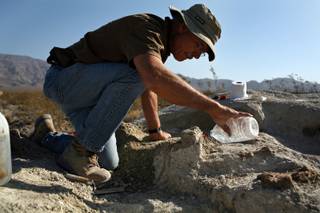
A look at the proposed Tule Springs National Monument area located in the northern part of the Las Vegas Valley.
Wednesday, June 27, 2012 | 9:30 p.m.
Sun Archives
- Legislation to create national monument at Tule Springs introduced in Congress (6-27-2012)
- Legislation preserving fossil-rich area north of Las Vegas as national monument expected this year (3-20-2012)
- Tule Springs tours offer vistas into the past (5-11-2005)
- Valley residents get chance to protect Las Vegas Wash (4-29-3005)
- Researchers hoping to protect fossil sites (12-8-2004)
- More ancient treasures found (10-1-2003)
- Revisiting Tule Springs' 'Big Dig' (11-1-2002)
Beyond the Sun
The Nevada delegation is expected to join forces to push for a new multiproject, multidisciplinary, and multimillion-dollar generating public lands bill, formally unveiled Wednesday in the Senate.
The crown jewel of the Las Vegas Valley Public Lands bill that Sen. Harry Reid introduced with Sen. Dean Heller as chief co-sponsor is the Tule Springs Fossil Beds National Monument, a sprawling 22,650-acre area that would be Nevada’s first national monument, if the bill is approved.
The area boasts some of Nevada’s oldest history: It dates back over 11,000 years, to the last Ice Age. More than 400 paleontological sites are within Tule Springs; they contain fossils of wooly mammoths, bison, lions and giant sloths, as well as human activity. The site also contains the Upper Las Vegas Wash, which feeds into the lower Las Vegas water systems that feed Lake Mead.
The designation of Tule Springs would not only put Nevada on the national monument map, it would serve to keep an important piece of the state’s history and ecology almost pristine. Part of the plan for Tule Springs reserves a corridor for NV Energy to build high-speed transmission facilities for renewable energy, which lawmakers estimate will help the area generate ample revenue for the state.
While the centerpiece of the bill is dedicated to preserving public land, the rest of it is geared toward getting unused ground up and running.
Many of the initiatives in the public lands bill have been percolating about Congress for years.
The bill frees up Bureau of Land Management land for the Nevada System of Higher Education to break ground on and expand college campuses at UNLV, the College of Southern Nevada and Great Basin Community College, for Metro Police to build an access road, and for Las Vegas and North Las Vegas to establish so-called “job creation zones” geared toward economic development. It also dedicates land to various bodies in Clark County for a water treatment facility, an off-road vehicle park at Nellis Dunes, and flood control work at the site designated for the new airport near Primm.
The final sections of the bill stop over 10,000 acres at Sunrise Mountain from being designated a wilderness area, authorize the national Forest Service to swap lands around the Spring Mountains National Recreation Area, and designate about 1,350 more acres of Red Rock Canyon as conservation area.
Reid called the bill “an ambitious piece of legislation, built on years of stakeholder input.”
“By making long-term and forward-looking improvements to public land management and stewardship in the Las Vegas Valley, I believe we have crafted a bill that will serve the best interests of Nevadans,” he added.
“This bill is a great example of how conservation, economic development and recreational opportunities can be achieved when stakeholders come together to work out their differences,” Heller said. “This multiyear effort shows what can be accomplished when all sides come together and work toward a common goal.”
Rep. Shelley Berkley will sponsor identical companion-legislation in the House of Representatives.


Join the Discussion:
Check this out for a full explanation of our conversion to the LiveFyre commenting system and instructions on how to sign up for an account.
Full comments policy